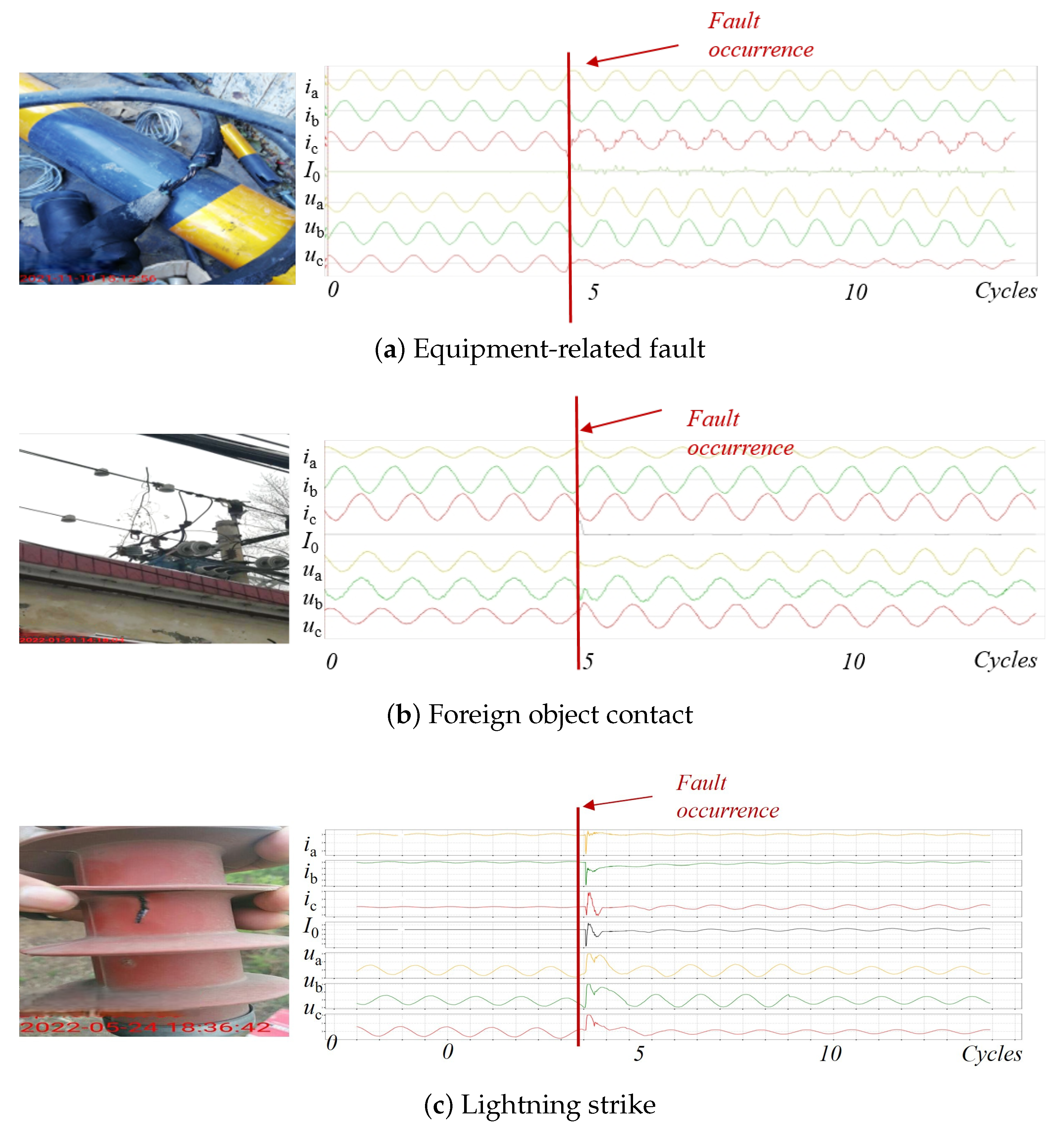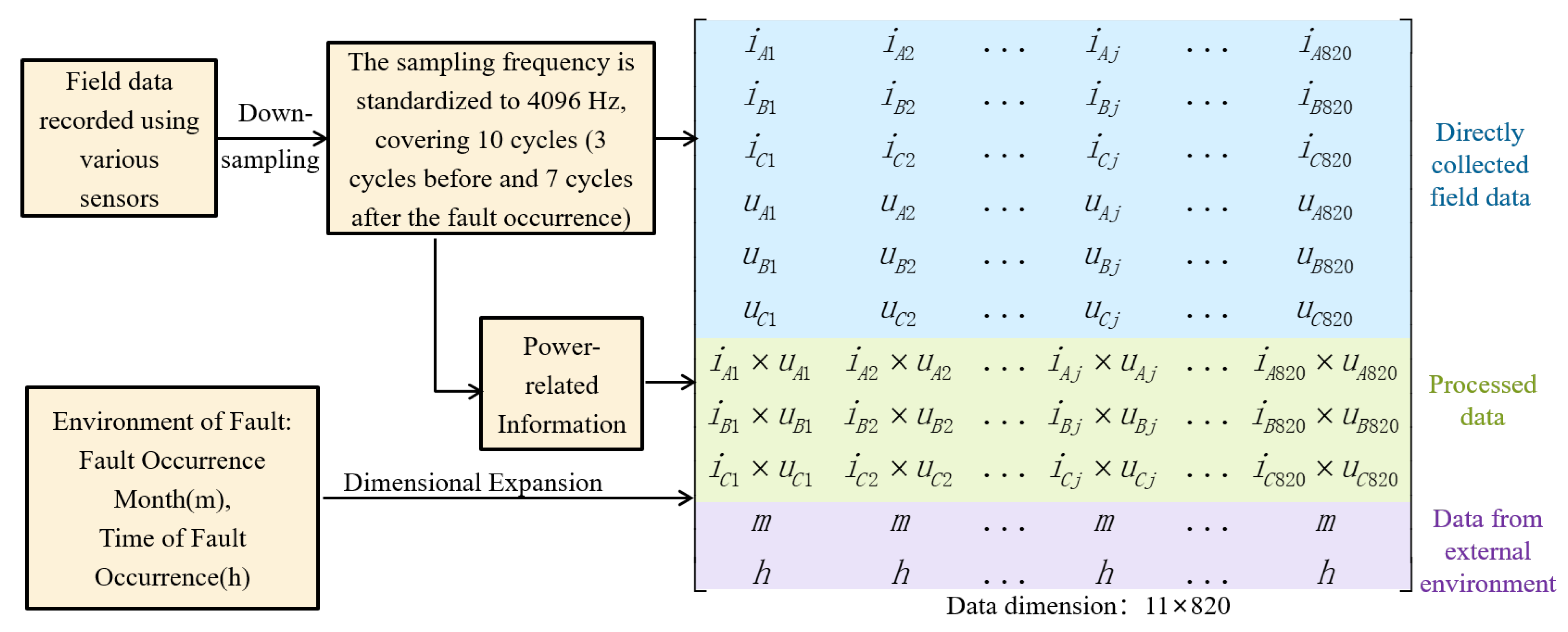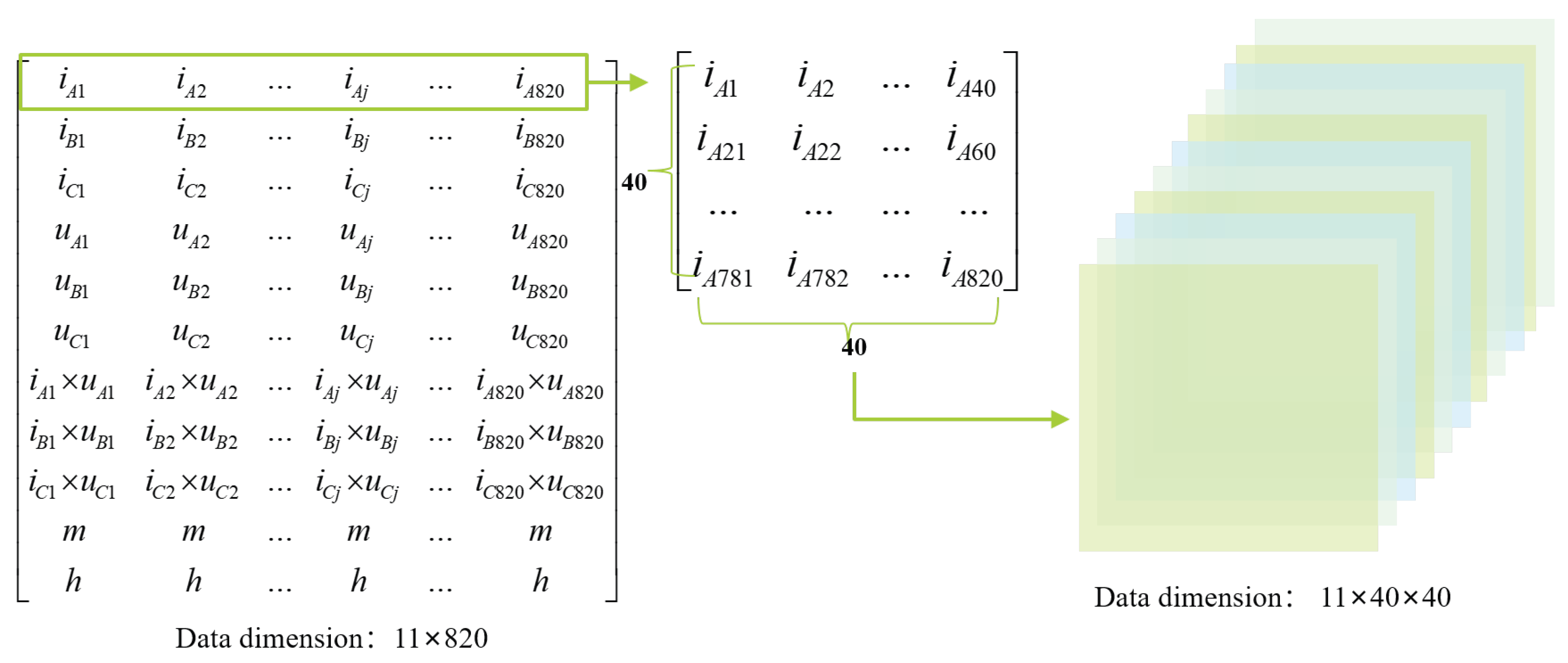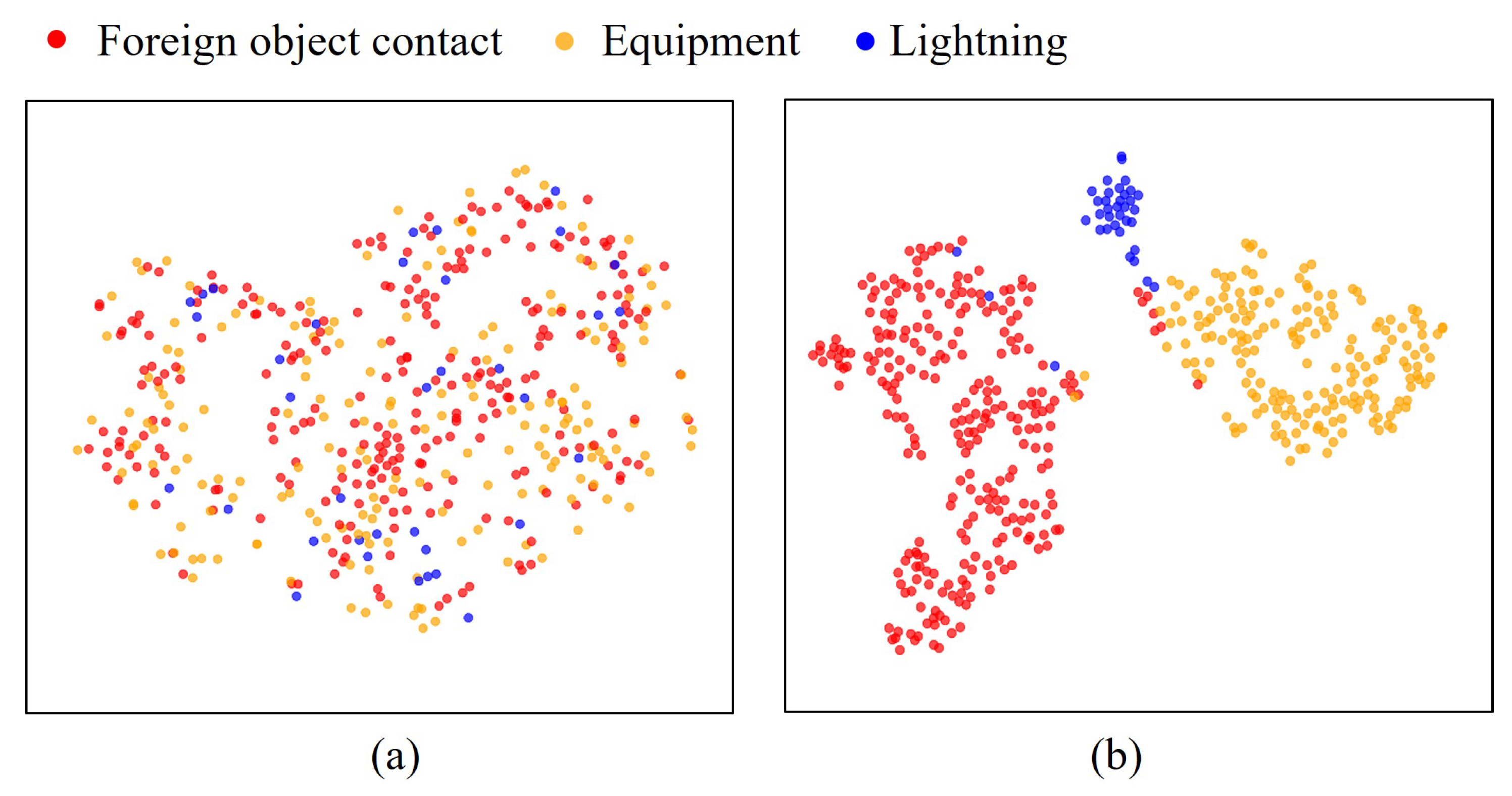A Real Data-Driven Fault Diagnosing Method for Distribution Networks Based on ResBlock-CBAM-CNN
Abstract
1. Introduction
- The proposed ResBlock-CBAM-CNN model enables a quick and accurate diagnosis of fault causes in power distribution systems, reducing the dependence on the personal experience of line patrols.
- To enhance fault diagnosis accuracy, this paper introduces the ResBlock-CBAM-CNN structure, which leverages channel and temporal attention mechanisms to improve the model’s ability to focus on critical features and time-based variations in power distribution systems.
- To improve identification accuracy, the paper introduces a multimodal data fusion method that extracts fault-related information by integrating raw on-site measurements, feature-processed data, and external environmental information.
2. Physical Mechanisms of the Fault Diagnosis Task and the Corresponding Fault Information Extraction Structure
2.1. Common Fault Types in Power Distribution Systems
2.2. Database Construction
2.3. Model Architecture Rationale and Data Fusion Motivation
2.4. Proposed Model Structure
2.5. Proposed Feature Engineering with Multimodal Data Fusion
2.5.1. Data Alignment
2.5.2. Multimodal Information Fusion
2.5.3. Z-Score Normalization
2.5.4. Data Reshape
2.6. Model Optimization Stage
3. Case Study
3.1. Comparison of Different Model Structures
3.2. Comparison of Different Feature Map Construction Methods
3.3. Comparative Analysis with Existing Methods
3.4. The Visualization of the Proposed Method
4. Conclusions
- (1)
- The proposed data-driven method enables automated fault identification with minimal reliance on manual expertise while maintaining high accuracy.
- (2)
- By fusing raw measurements, processed operational parameters, and environmental data, the model overcomes the limitations of single-source data analysis, enhancing its ability to differentiate complex fault patterns.
- (3)
- The proposed framework integrates the CNN backbone for temporal sequence analysis, the CBAM module for adaptive feature refinement, and the ResBlock architecture for deep structural learning. By aligning these components with the intrinsic fault characteristics of power distribution systems, the framework significantly enhances fault identification accuracy.
Author Contributions
Funding
Data Availability Statement
Conflicts of Interest
References
- Liang, J.F. Research on rapid diagnosis method of single-phase grounding fault in distribution network based on deep learning. In Proceedings of the Chinese Automation Congress (CAC), Hangzhou, China, 22–24 November 2019. [Google Scholar]
- Xu, L.; Chow, M.; Timmis, J. Power distribution outage cause identification with imbalanced data using artificial immune recognition system (AIRS) algorithm. IEEE Trans. Power Syst. 2007, 22, 198–204. [Google Scholar]
- Morales, J.; Orduna, E.; Rehtanz, C. Identification of lightning strike due to shielding failure and back flashover for ultra-high-speed transmission-line protection. IEEE Trans. Power Deliv. 2014, 29, 2008–2017. [Google Scholar] [CrossRef]
- Xu, L.; Chow, M. A classification approach for power distribution systems fault cause identification. IEEE Trans. Power Syst. 2006, 21, 53–60. [Google Scholar]
- Li, Y.; Song, X.; Zhao, S.; Gao, F. A line fault cause analysis method for distribution network based on decision-making tree and machine learning. In Proceedings of the Fifth Asia Conference on Power and Electrical Engineering (ACPEE), Chengdu, China, 4–7 June 2020. [Google Scholar]
- Guo, M.; Yang, N.; Chen, W. Deep-learning-based fault classification using Hilbert–Huang transform and convolutional neural network in power distribution systems. IEEE Sens. J. 2019, 19, 6905–6913. [Google Scholar]
- Dehghani, M.; Khooban, M.H.; Niknam, T. Fast fault detection and classification based on a combination of wavelet singular entropy theory and fuzzy logic in distribution lines in the presence of distributed generations. Int. J. Electr. Power Energy Syst. 2016, 78, 455–462. [Google Scholar] [CrossRef]
- Jamil, M.; Singh, R.; Sharma, S.K. Fault identification in electrical power distribution system using combined discrete wavelet transform and fuzzy logic. J. Electr. Syst. Inf. Technol. 2015, 2, 257–267. [Google Scholar] [CrossRef]
- Chen, K.; He, Z.; Wang, S.X.; Hu, J.; Li, L.; He, J. Learning-based data analytics: Moving towards transparent power grids. CSEE J. Power Energy Syst. 2018, 4, 67–82. [Google Scholar]
- Fang, J.; Liu, C.; Zheng, L.; Su, C. A data-driven method for online transient stability monitoring with vision-transformer networks. Int. J. Electr. Power Energy Syst. 2023, 146, 108669. [Google Scholar]
- Fang, J.; Chen, K.; Liu, C.; He, J. An Explainable and Robust Method for Fault Classification and Location on Transmission Lines. IEEE Trans. Ind. Inform. 2023, 19, 10182–10191. [Google Scholar]
- Samantaray, S.R.; Kamwa, I.; Joos, G. Phasor measurement unit based wide-area monitoring and information sharing between microgrids. IET Gener. Transm. Distrib. 2017, 11, 1293–1302. [Google Scholar]
- Woo, S.; Park, J.; Lee, J.Y.; Kweon, I.S. CBAM: Convolutional Block Attention Module. In Computer Vision—ECCV 2018; Ferrari, V., Hebert, M., Sminchisescu, C., Weiss, Y., Eds.; Lecture Notes in Computer Science; Springer: Cham, Switzerland, 2018; Volume 11211. [Google Scholar]
- Ioffe, S.; Szegedy, C. Batch Normalization: Accelerating Deep Network Training by Reducing Internal Covariate Shift. In Proceedings of the International Conference on Machine Learning, Lille, France, 6–11 July 2015; Volume 37, pp. 448–456. [Google Scholar]
- Lecun, Y.; Bottou, L.; Bengio, Y.; Haffner, P. Gradient-based learning applied to document recognition. Proc. IEEE 1998, 86, 2278–2324. [Google Scholar]
- Liu, L.; Jiang, H.; He, P.; Chen, W.; Liu, X.; Gao, J.; Han, J. On the Variance of the Adaptive Learning Rate and Beyond. arXiv 2021, arXiv:1908.03265. Available online: https://arxiv.org/abs/1908.03265 (accessed on 26 October 2021).
- Cortes, C.; Mohri, M. AUC Optimization vs. Error Rate Minimization. In Advances in Neural Information Processing Systems. Adv. Neural Inf. Process. Syst. 2004, 11, 356–360. [Google Scholar]
- Zhou, Y.; Guo, Q.; Sun, H.; Yu, Z.; Wu, J.; Hao, L. A novel data-driven approach for transient stability prediction of power systems considering the operational variability. Int. J. Electr. Power Energy Syst. 2019, 107, 379–394. [Google Scholar] [CrossRef]
- Wang, J.; Sima, W.; Yang, Q. Classification and identification of over-voltage based on HHT and SVM. In Proceedings of the International Conference on High Voltage Engineering Application, New Orleans, LA, USA, 11–14 October 2010. [Google Scholar]
- Liu, W.; Hao, D.; Zhang, S.; Zhang, Y. Power System Transient Stability Assessment Based on PSO-DBN. In Proceedings of the 2021 6th International Conference on Power and Renewable Energy (ICPRE), Shanghai, China, 17–20 September 2021; pp. 333–337. [Google Scholar]
- Cheng, S.J. An Analysis of Prospects for Application of Large-scale Energy Storage Technology in Power Systems. Autom. Electr. Power Syst. 2013, 37, 3–8. [Google Scholar]





| Layer Type | Parameters |
|---|---|
| Conv1 | Out Channels: 16, Kernel Size: (3, 3) |
| BatchNorm1 | - |
| ReLU1 | - |
| MaxPool1 | Kernel Size: (2, 2), Stride: 2 |
| CBAM1 | Reduction Ratio: 16, Kernel Size: (7, 7) |
| ResBlock1 | Skip connection: Conv1 + CBAM1 |
| Conv2 | Out Channels: 16, Kernel Size: (3, 3) |
| BatchNorm2 | - |
| ReLU2 | - |
| MaxPool2 | Kernel Size: (2, 2), Stride: 2 |
| CBAM2 | Reduction Ratio: 16, Kernel Size: (7, 7) |
| ResBlock2 | Skip connection: Conv2 + CBAM2 |
| Conv3 | Out Channels: 8, Kernel Size: (3, 3) |
| BatchNorm3 | - |
| ReLU3 | - |
| MaxPool3 | Kernel Size: (2, 2), Stride: 2 |
| CBAM3 | Reduction Ratio: 8, Kernel Size: (7, 7) |
| ResBlock3 | Skip connection: Conv3 + CBAM3 |
| Fully connected1 | Out Features: 32 |
| BatchNorm4 | - |
| ReLU4 | - |
| Dropout | Dropout Rate: 0.5 |
| Fully connected2 | Out Features: 2 (Softmax Output) |
| Conv | ResBlock | CBAM | BatchNorm | Accuracy (%) | F1-Score (%) |
|---|---|---|---|---|---|
| ✔ | 86.32 | 84.29 | |||
| ✔ | ✔ | 88.45 | 86.18 | ||
| ✔ | ✔ | ✔ | 90.56 | 89.03 | |
| ✔ | ✔ | ✔ | 91.12 | 89.70 | |
| ✔ | ✔ | ✔ | ✔ | 94.57 | 92.82 |
| Raw Record Data (Current, Voltage) | Power-Related Data | Month | Time of Day | Accuracy (%) | F1-Score (%) |
|---|---|---|---|---|---|
| ✔ | 74.62 | 71.28 | |||
| ✔ | ✔ | 82.17 | 80.45 | ||
| ✔ | ✔ | ✔ | 86.28 | 85.12 | |
| ✔ | ✔ | ✔ | 91.42 | 89.67 | |
| ✔ | ✔ | ✔ | ✔ | 94.57 | 92.82 |
| Method | Accuracy (%) | F1-Score (%) |
|---|---|---|
| The proposed method | 94.57 | 92.82 |
| RHN | 90.21 | 88.78 |
| BiLSTM | 91.05 | 88.75 |
| GRU | 85.12 | 84.01 |
| DBN | 85.02 | 83.10 |
| DT | 82.23 | 80.82 |
| SVM | 81.98 | 80.68 |
| MLP | 75.22 | 74.03 |
Disclaimer/Publisher’s Note: The statements, opinions and data contained in all publications are solely those of the individual author(s) and contributor(s) and not of MDPI and/or the editor(s). MDPI and/or the editor(s) disclaim responsibility for any injury to people or property resulting from any ideas, methods, instructions or products referred to in the content. |
© 2025 by the authors. Licensee MDPI, Basel, Switzerland. This article is an open access article distributed under the terms and conditions of the Creative Commons Attribution (CC BY) license (https://creativecommons.org/licenses/by/4.0/).
Share and Cite
Yao, Y.; Ma, H.; Gong, C.; Li, Y.; Zhao, Q.; Wei, N.; Yang, B. A Real Data-Driven Fault Diagnosing Method for Distribution Networks Based on ResBlock-CBAM-CNN. Electricity 2025, 6, 19. https://doi.org/10.3390/electricity6020019
Yao Y, Ma H, Gong C, Li Y, Zhao Q, Wei N, Yang B. A Real Data-Driven Fault Diagnosing Method for Distribution Networks Based on ResBlock-CBAM-CNN. Electricity. 2025; 6(2):19. https://doi.org/10.3390/electricity6020019
Chicago/Turabian StyleYao, Yuhai, Hao Ma, Cheng Gong, Yifei Li, Qiao Zhao, Ning Wei, and Bin Yang. 2025. "A Real Data-Driven Fault Diagnosing Method for Distribution Networks Based on ResBlock-CBAM-CNN" Electricity 6, no. 2: 19. https://doi.org/10.3390/electricity6020019
APA StyleYao, Y., Ma, H., Gong, C., Li, Y., Zhao, Q., Wei, N., & Yang, B. (2025). A Real Data-Driven Fault Diagnosing Method for Distribution Networks Based on ResBlock-CBAM-CNN. Electricity, 6(2), 19. https://doi.org/10.3390/electricity6020019







